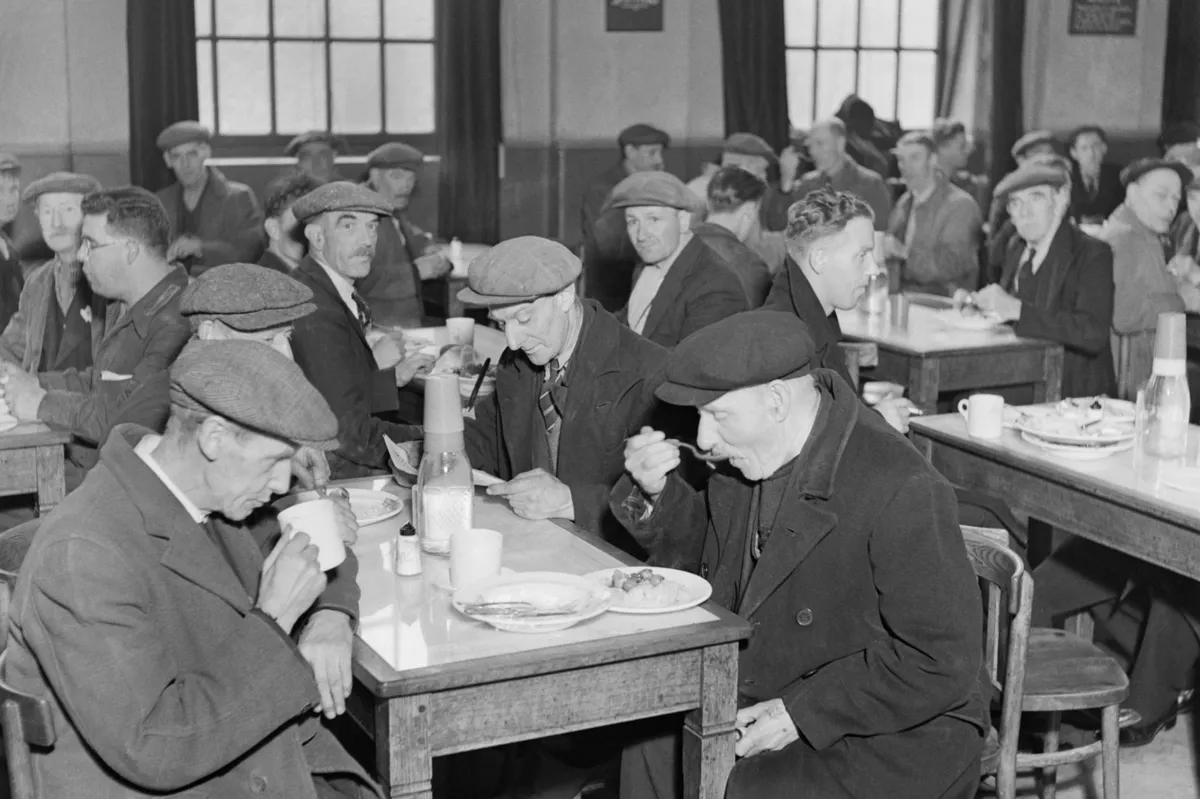Canteen dining has something of an image problem; most of us will think of school dinners, with overcooked food and wet trays. Yet canteen dining was a staple of 20th century Britain, and this way of eating took place on a mass scale outside the workplace, school or other institution, on every high street in Britain.
British Restaurants were public dining rooms offering price-capped and nutritious meals in the 1940s and 1950s. This national feeding network was administered by the wartime Ministry of Food (MOF), which had pioneered a similar scheme, National Kitchens, during the First World War.
The British Restaurant name was coined by Prime Minister Winston Churchill in 1940. Churchill, a passionate foodie, thought that the MOF’s preferred title – ‘Communal Feeding Centres’ – conjured up images of the workhouse or Soviet monotony. Instead, he insisted that they should be attractive places to visit. Accordingly, British Restaurants occupied prime retail spaces on high streets, and the MOF funded the outfitting of these sites as smart restaurant premises featuring music, flowers and attractive interior design. This included bright, multicoloured seats and furniture, and specially commissioned artwork. The restaurants were also regularly inspected to ensure compliance with hygiene and food standards.
The British Restaurants’ function was to combat the inflation in the price of food and fuel during the Second World War, and boost public morale through attractive yet cheap mass social eating. After receiving a start-up grant from the Treasury, local government was responsible for recruiting a paid staff. Each British Restaurant was to be run on a commercial basis: if a venue did not at least break even, then it did not qualify for future capital grants. There was a degree of autonomy over menus, but not pricing, which had to conform to the MOF’s price structure.
Under the avuncular minister of food Lord Woolton, who had made his name at high-street retailer Lewis’s, the state worked with private enterprise to ensure that the restaurants looked like attractive commercial premises.

When it came to menus, popular taste and nutritional science clashed. One the one hand, the MOF’s nutritionists were keen to get the Great British public eating more vegetables. On the other, there was a general public resistance to healthier fare. While the nutritionists attempted to push thick and hearty vegetable soups and the ‘Oslo Breakfast’ (a version of the continental breakfast), many people suffering the trauma of the Blitz simply preferred to eat comfort food: fish and chips, sausage rolls and KitKats. A balance was struck, with main meals roughly resembling the ‘meat and two veg’ fare of traditional British taste.
Celebrity endorsement was key, and in 1941 the Ministry of Information recruited a music-hall comedian to promote British Restaurants in a short film. Eating Out With Tommy Trinder sees the star enthuse, “Look what you get for four and tuppence. Blimey, they’re giving the stuff away!” He also praises the food’s quality and the state-of-the-art technology of the kitchen that prepared it, in a film aimed at working-class and middle-class housewives, many of whom would undoubtedly have seen ‘eating out’ as an exotic privilege of the upper class.
In fact the British Restaurant initiative would receive celebrity endorsement from various quarters: writers JB Priestley and Barbara Cartland, to name but two, were enthusiasts. But social eating had its detractors too. The writer Frances Partridge described her local venue as “a huge elephant house” full of noisy and uncouth people, while the Conservative MP Sir William Darling argued that state-sponsored canteens were “brutal in their cooking, and brutal in their presentation of food”.
Similarly, the verdicts on the restaurants from Mass Observation diaries kept by ordinary people during the Second World War are mixed. For example, the experience of communal dining could be, for the same woman, in December 1941 “not so bad” with “generous helpings of soup, meat, vegetables and a sweet for just nine pence”; in March 1942 her public feeding experience got even better, with a lunch of beef, potatoes, bread pudding, custard and coffee proving “satisfying”; by the next month, in contrast, it was “dreadful”, with the “liberal use of sage and onion” in the mock goose causing her “hours of pain and discomfort” afterwards.
Such sniffy verdicts belie the popularity of the project. British Restaurants were but one arm of a greatly expanded wartime public feeding network that operated alongside the ration. As such they were an ‘eat out’ option and never a primary food provider: this remained the function of the ration book. Nevertheless, by 1944 the restaurants were registering impressive net profits nationwide. For the financial year 1943-44 their collective turnover was £170,000, which is equivalent to somewhere in the region of £6 million today.
At peak there were 2,160 British Restaurants, most occupying prime retail space on high streets in towns and cities; by way of comparison, there are about 1,400 McDonald’s restaurants in the UK today. Churchill continued to back British Restaurants late into the war, claiming that they had “served a most useful purpose and should not be allowed to disappear”. Yet disappear they gradually did. The scheme outlasted the war, but numbers were already in decline when rationing was lifted in 1954.
